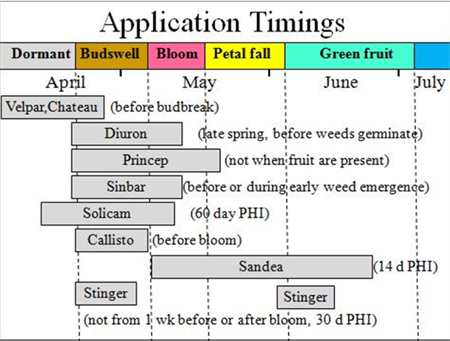Spring herbicide choices for blueberries
Review the products available for weed management this spring
Spring is an important time for weed management choices. Several old and new herbicides are now available, and recommendations for their use are outlined in MSU Extension Bulletin E-154, Fruit Management Guide. Be familiar with herbicide labels and precautions. Poor herbicide choices can injury blueberries or provide poor weed control.
Princep (simazine), Karmex (diuron), Sinbar (terbacil), and Solicam (norflurazon) are older preemergent herbicides that most growers have worked with. Costs are low (Princep, Karmex) to moderate (Sinbar, Solicam). Princep and Karmex are stronger on broadleaf weeds, whereas Sinbar and Solicam are effective on grasses. Combining broadleaf and grass materials controls a broader spectrum of annual weeds. These materials control many germinating annual weeds for 1 to 3 months. Effective timings are mid-April through early May, and in the late fall. Solicam tends to last longer than the other materials. Sinbar and Solicam present the greatest risk.
Chateau is a newer preemergent product with some postemergent activity if applied with surfactant or crop oil concentrate (COC). Chateau controls a wide range of broadleaf and grass weeds, including chickweeds, dandelion, common groundsel, lambsquarters, eastern black nightshade, several pigweeds, ragweed, and most annual grasses. Apply Chateau before bud break at 6 to 12 oz product per acre. Bushes need to have been in the field for 2 years. Chateau also provides a longer period of control than most blueberry herbicides, so it is effective in the late fall as well as the spring. Chateau will burn developing buds and young leaves if the base of plants is sprayed.
Callisto provides preemergent and postemergent control of several pigweed species, chickweeds, horsenettle, lambsquarters, marestail, eastern black nightshade, ragweed, and smartweed. It is weak on grasses so it should be combined with a grass herbicide. Apply Callisto before bloom, either in one 6 fl. oz. per acre application, or two 3 oz. applications at least 14 days apart. Postemergent activity is improved with COC, but Callisto with COC will also injure blueberry leaves and young stems that are contacted. Callisto is labeled for young, non-bearing and bearing blueberries. For effective postemergent activity, delay Callisto treatments until weeds have begun growing. Callisto will suppress some perennial weeds such as aster and goldenrod.
Sandea was just labeled for Michigan blueberries, and provides preemergent and postemergent control of many broadleaf weeds. The primary value of Sandea is for yellow nutsedge control. Treat nutsedge when 3 to 5 leaves are present. Two applications with non-ionic surfactant are most effective. Rates are 0.5 to 1.0 oz per acre and no more than 2 oz per year. Pre-harvest interval is 14 days. Sandea also controls pigweed, ragweed, and smartweed.
Stinger was also just labeled for Michigan blueberries and also has preemergent and postemergent activity. Stinger is most active on weeds in the composite and legume families, such as thistle, asters, dandelion, goldenrod, ragweed, and clovers. It also controls nightshades, smartweeds, wild buckwheat and plantain, as well as wild bean or groundnut. Timing is somewhat complicated. Blueberries are most sensitive to Stinger near bloom, so it should not be applied from one week before to one week after bloom. PHI is 30 days. The best times for treatment appear to be before bloom when weeds are growing, shortly after bloom but not within 30 days of harvest, and after harvest. Rates are 2.6 to 5.3 fl oz per acre, and not more that 10.6 oz per season. Stinger is a residual material, so accurate rates per acre are important, even if spot treating by hand.
SelectMax was just labeled for bearing blueberries. This is a selective, postemergent grass herbicide similar to Poast and Fusilade. Like the other grass herbicides, SelectMax needs to be applied when grass is growing actively early in the season. Use 9 to 16 fl oz per acre with a non-ionic surfactant for best effect.
Application timing
Optimizing timing is confusing because some of the newer materials are different from the older products. Materials with strong posteemergent activity (Callisto, Sandea, Stinger) need to be applied to emerged weeds for best control, but label restrictions need to be followed. Others can only be applied prior to bud break (Chateau, Velpar). The chart below should help determine application timing. Time herbicide based on plant development, not calendar dates.

Herbicide combinations are often needed for control of a broader range of weeds. Combining herbicides with different modes of action (see Table 1) also reduces the potential to develop resistant weed populations. Growers should work with the newer products (Callisto, Chateau, Sandea, Stinger) to learn how they perform on their farms. These herbicides have different modes of action than the traditional blueberry herbicides such as Princep, Karmex, and Sinbar. As a result, they should be helpful in discouraging development of herbicide resistant weed populations.
| Table 1. Common modes of action of preemergent blueberry herbicides | |
| Herbicide | Mode of action |
| Karmex, Princep, Sinbar, Velpar | Inhibit photosystem II |
| Casoron | Inhibit cellulose synthesis (cell walls) |
| Sandea | ALS Inhibitor |
| Solicam | Disrupt carotinoid synthesis (pigments) |
| Surflan | Inhibit microtubules (cell division) |
| Devrinol | Inhibit VLCFA’s (cell division) |
| Callisto | HPPD inhibitor (pigments) |
| Chateau | PPO inhibitor (disrupts membranes) |



 Print
Print Email
Email




